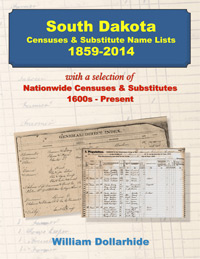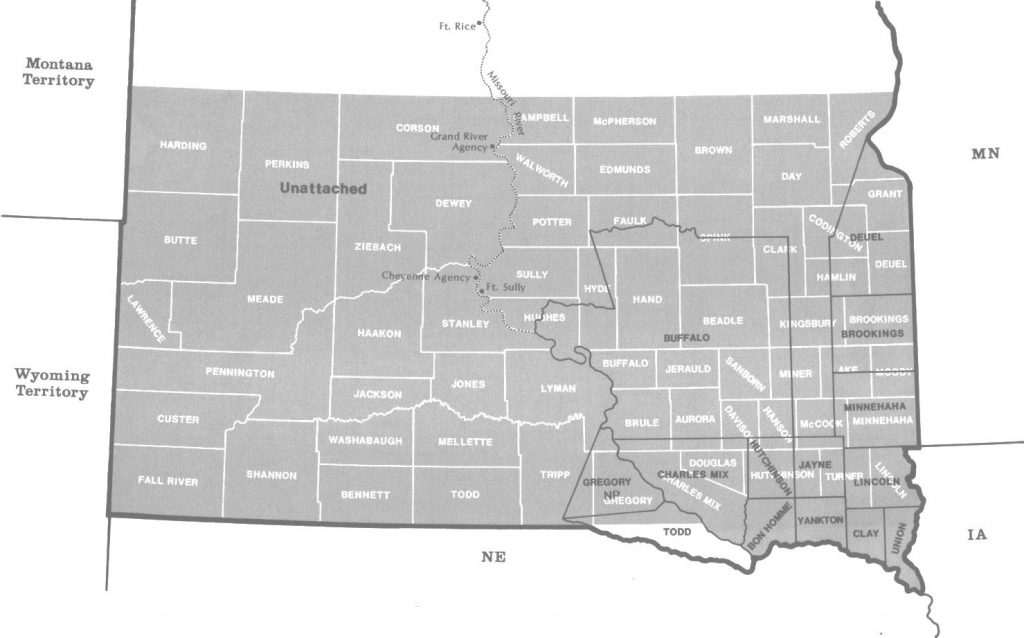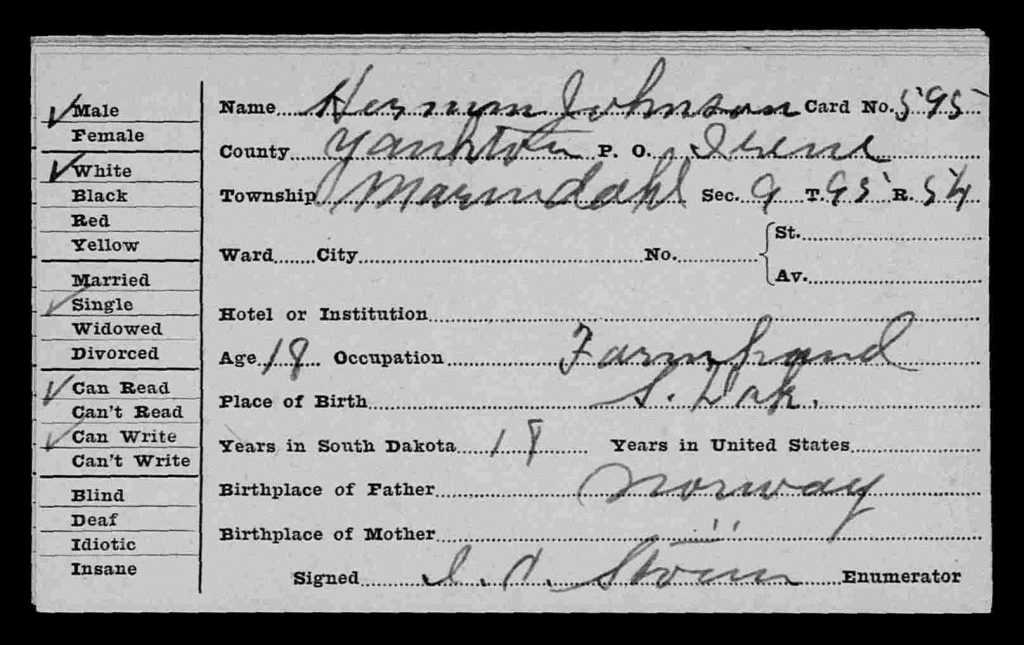This following article is by my friend Bill Dollarhide, taken from his book, South Dakota Censuses & Substitute Name Lists, 1859-2014
 Prologue: This historical timeline begins with the French fur-trading excursions into the Dakota Country; followed by the names, places, and events important to the peopling of the South Dakota area , up to the year of South Dakota’s State Census of 1945.
Prologue: This historical timeline begins with the French fur-trading excursions into the Dakota Country; followed by the names, places, and events important to the peopling of the South Dakota area , up to the year of South Dakota’s State Census of 1945.
1738. Dakota Country. French explorer Pierre Gaultier de la Vérendrye visited Mandan villages near the Missouri River. This was the first known white expedition into the Dakota Country.
1763. Treaty of Paris. This was the end of the French and Indian war. (In Europe it was called the “Seven Years War.”) At the 1763 treaty, the French surrendered all their claims in North America. Spain acquired the former French areas west of the Mississippi, renamed Spanish Louisiana. Great Britain gained all of Québec, which they immediately renamed the Province of Canada. Britain also gained control of the rest of North America east of the Mississippi River. They named their entire area British North America.
1783. Treaty of Paris. As the official end of the Revolutionary War, the 1783 treaty recognized the United States as an independent republic, with borders from the Atlantic Ocean to the Mississippi River. The treaty also reaffirmed the claims of Britain to present-day Canada; and Spain’s claim to lands west of the Mississippi River.
1792. Dakota Country. French-Canadian trader Jacques D’Englise opened trade on the Missouri River between Mandan villages and his Spanish employers located at St. Louis.
1797. Dakota Country. North West Fur Company fur trader Jean Baptiste Chaboillez of the Red River Settlement (present Manitoba), established a trading post at Pembina (present North Dakota).
1800. Louisiana. Napoleon acquired title of Louisiana from Spain. At the Third Treaty of San Ildefonso, the Spanish acknowledged that it was too costly to explore the country and could not see the rewards being worth the investment. Spain retroceded Louisiana to France in exchange for the Grand Duchy of Tuscany (now part of Italy).
1803. Louisiana Purchase. The United States purchased Louisiana from France. Sent by President Jefferson to attempt the purchase of New Orleans, the American negotiators (James Madison and Robert Livingston) were surprised when Napoleon offered the entire tract to them. The Louisiana Purchase was officially described as the “drainage of the Mississippi and Missouri River basins.” Adding the area doubled the size of the United States.
1804. Lewis and Clark Expedition. On a expedition ordered by President Thomas Jefferson, Captains Meriwether Lewis and William Clark’s Corps of Discovery left St. Louis in search of a passage to the Pacific Ocean. Based on bad information from his spies, the Spanish governor of New Mexico dispatched soldiers from Santa Fe to the Arkansas River to intercept the party and arrest them. But, the Lewis and Clark party had taken a more northern route, following the Missouri River.
1804-1805. In 1804, Congress divided the Louisiana Purchase into two jurisdictions: Louisiana District and Orleans Territory. The latter had north and south bounds the same as the present state of Louisiana, but did not include land east of the Mississippi River, and its northwestern corner extended on an indefinite line west into Spanish Texas. For a year, Louisiana District was attached to Indiana Territory for judicial administration, but became Louisiana Territory with its own Governor on July 4, 1805.
1805. 1st Pike Expedition. U.S. Army Lieutenant Zebulon Pike led a small party of soldiers to investigate the Mississippi River above St. Louis. He was given specific orders to find the source of the Mississippi, and while doing so, to note “…any rivers, prairies, islands, mines, quarries, timber, and any Indian villages and settlements encountered.”
1805. Louisiana Territory in 1805 had five original subdivisions: St. Louis District, St. Charles District, Ste. Genevieve District, Cape Girardeau District and New Madrid District. The unpopulated area north of these original districts was referred to as Upper Louisiana, and included all lands north to the U.S./British border and west to the Continental Divide.
1812. June 4th. Louisiana Territory was renamed Missouri Territory. This was to avoid any confusion after Orleans Territory became the State of Louisiana on April 30, 1812. The General Assembly of the Territory of Missouri met in St. Louis in October, and converted the first five original districts into counties: Cape Girardeau, New Madrid, St. Charles, St. Louis, and Ste. Genevieve. A year later, the territorial legislature created Arkansas County from lands ceded by the Osage Indians.
1818. Anglo-American Convention. The 49th parallel was agreed to as the boundary between the U.S. and the British territory of Rupert’s Land. In the treaty, the United States acquired part of the Red River drainage in present Minnesota and North Dakota, and ceded part of the Missouri River drainage in present North Dakota and Montana.
1832. After dredging projects near the mouth of the Kansas River, steamboat traffic continued up the Missouri River. In 1832, the steamboat Yellowstone began the first of its annual fur-trading voyages up the Missouri River, reaching Fort Union (present North Dakota/Montana line).
1833. June 1st. Black Hawk Cession. After the Black Hawk War of 1832, the Sauk and Fox tribe of present-day Iowa was forced to cede land on the west side of the Mississippi River to the United States. The cession opened a large area of the Ioway Country for legal white settlement for the first time.
1836. Wisconsin Territory was created, taken from Michigan Territory. Its area extended from its present Lake Michigan border to the Missouri River.
1838. Iowa Territory was created, encompassing all lands north of the state of Missouri between the Mississippi and Missouri Rivers.
1854. May 30th. Kansas-Nebraska Act passed the U.S. Congress. The territories of Kansas and of Nebraska were established. The act also allowed residents of the two territories to decide for themselves whether or not to allow slavery within their borders. Separated on their present common boundary, Nebraska Territory and Kansas Territory both extended from the Missouri River to the Continental Divide. Nebraska Territory included parts of present North Dakota, South Dakota, Montana, and Wyoming. Kansas Territory included present Kansas and parts of present Colorado.
1858-1861. Unorganized Dakota. When Minnesota was admitted as a state in 1858 with its present boundaries, part of the Dakota Country was orphaned. The area from the western Minnesota line to the Missouri River was enumerated in the 1860 federal census as Unorganized Dakota. This was not an official jurisdiction, but one invented by the Census Office to gather census data for the Red River/Pembina settlements, plus a series of outposts along the Missouri River.
1861. Mar. Dakota Territory was created by Congress. The original area included all of present North Dakota, South Dakota, and the parts of present Montana and Wyoming east of the Continental Divide. Yankton was the first territorial capital, replaced by Bismarck in 1863.
1870. Map of South Dakota (as part of Dakota Territory) Notes: The paper county of Gregory is shown as NP (no population). The agencies and forts follow Yankton County on the microfilmed census. An area between the Keya Paha and Niobrara Rivers in old Todd County, Dakota Territory, was transferred to Nebraska in 1882. Old Todd disappeared, the current Todd County, SD, was created in 1909. Map source: Page 307, Map Guide to the U.S. Federal Censuses, 1790-1920.
1885. Dakota Territory Census. The first censuses in the South Dakota area began with the Dakota Territory census of 1885, which was later divided by northern and southern counties. The originals for the southern portion are located today at the South Dakota State Historical Society (SDSHS) in Pierre, SD.
1889. Nov. South Dakota and North Dakota both admitted as states with the same boundaries as today. Although Dakota Territory had petitioned Congress to be a single state, that would have caused two Democratic senators to be added, which would have upset the balance in Congress. By splitting Dakota Territory into two states, two Republican senators and two Democratic senators were added to Congress, maintaining the balance of power.
1895-1945 South Dakota State Censuses. After statehood in 1889, South Dakota began taking state censuses as a means of apportionment of their state legislature. The first one was for 1895, taken with a page format with names of persons listed without relationships, ages in categories, and nationalities. Unfortunately, only six counties for the SD 1895 State Census have survived. Subsequent state censuses taken every ten years, 1905 through 1945, are virtually complete for all counties, the originals located today at the SDSHS. The 1905, 1915, 1925, 1935, and 1945 censuses were all tabulations compiled on 3 x 5 index cards, one card per person, giving a full name and detailed personal information for each. The ingenious South Dakotans made use of college and high school students to take their censuses, using sortable index cards for each person enumerated. The cards were then arranged in alphabetical order by surname for the entire state, which is how the censuses are still organized and stored today at the SDSHS archives. The digitized card index database allows for a global search within the state, and is very convenient for finding an individual, regardless of name, age, or place of residence. But, using the digitized index cards to recreate a family grouping is rather daunting. Since the card sequence numbers are not part of the search criteria, one can not recreate the original order the cards were prepared house to house. A search for one name needs to be followed by a search for people at the same street address, or perhaps common keywords, but, there is no proof of relationship possible, because the individual cards do not indicate a name of a parent, or the names of any children. In spite of the family grouping limitation, the South Dakota state censuses all have details about a person rarely found in other state censuses, e.g., for 1915, 1925, and 1935, the SD index cards ask for the maiden name of a wife, a census question found only in South Dakota.
Sample Card from the SD 1905 State Census. Taken from South Dakota State Census, 1905 [Online Database], digitized and indexed at the FamilySearch.org website. Source: SDSHS, state archives microfilm collection. This database is an index and images to the 1905 census cards, filed in alphabetical order for the entire state. Each index record includes: Name, Age, Birth year, Gender, Race, Birthplace, Marital Status, Years in state, Arrival year in state, Event place (South Dakota), Years in the U.S., Father’s birthplace, and Mother’s birthplace. View the image of the card to add information, such as Occupation, Post Office, Named township, and property description (Section, Township, and Range). This database has 472,575 records. See www.familysearch.org/search/collection/1477737.
South Dakota Censuses Online:
– Ancestry.com: Digitized and Indexed 1885 Dakota Territory Census (southern counties); and digitized and indexed 1895 SD State Census (partial); and indexed only 1905, 1915, 1925, 1935 & 1945 SD State Census.
– FamilySearch.org: Digitized and Indexed SD State Censuses: 1905, 1915, 1925, 1935 & 1945.
– SDSHS Website: Indexed SD State Census: 1905 only.
Further Reading:
South Dakota Censuses & Substitute Name Lists, 1859-2014 (Printed Book), Softbound, 79 pages, Item FR0291.
South Dakota Censuses & Substitute Name Lists, 1859-2014 (PDF eBook), 79 pages, Item FR0292.
Online South Dakota Censuses & Substitutes: A Genealogists’ Insta-Guide™ Laminated, 4 pages, 3-hole punched, Item FR0361.
Online South Dakota Censuses & Substitutes: A Genealogists’ Insta-Guide™ 4-pages, Item FR0362.

